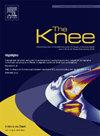Can the combination of kinematics and electromyography enhance the identification of individuals with patellofemoral pain?
IF 1.6
4区 医学
Q3 ORTHOPEDICS
引用次数: 0
Abstract
Background
Patellofemoral pain (PFP) affects many women’s movement function and quality of life. PFP is related to changes in muscle activity and movement patterns during functional tasks. This study aimed to determine whether the combined analysis of kinematics and electromyography data enhances the ability to discriminate between women with and without PFP, compared with the independent analysis of kinematics and electromyography.
Methods
Thirty-seven women with PFP and 34 unimpaired controls were evaluated for kinematics and electromyography during the lateral step-down (LSD) task. For three-dimensional kinematics, movements in the sagittal, frontal, and transverse planes of the trunk, pelvis, hip, knee, and foot were assessed. For electromyography, filtered, rectified, and smoothed signals from the adductor longus, gluteus medius, vastus lateralis and medialis, rectus femoris, biceps femoris, medial gastrocnemius and tibialis anterior muscles were used. The artificial neural network-based movement deviation profile (MDP) was used to analyse kinematics, electromyography and kinematics combined with electromyography. A MANOVA of MDPmean Z-scores was used to compare the groups, considering P < 0.05.
Results
Multivariate analysis showed group interaction. There was a significant difference between groups in the Z-score for kinematics. However, no significant differences were observed between groups for electromyography and kinematics combined with electromyography.
Conclusion
Women with PFP exhibit altered movement patterns during the LSD task but no change in the MDP of muscular activity. Using the MDP, which can combine kinematic and electromyography variables from different segments and muscles, kinematics was the most influential in distinguishing between women with and without PFP.
求助全文
约1分钟内获得全文
求助全文
来源期刊

Knee
医学-外科
CiteScore
3.80
自引率
5.30%
发文量
171
审稿时长
6 months
期刊介绍:
The Knee is an international journal publishing studies on the clinical treatment and fundamental biomechanical characteristics of this joint. The aim of the journal is to provide a vehicle relevant to surgeons, biomedical engineers, imaging specialists, materials scientists, rehabilitation personnel and all those with an interest in the knee.
The topics covered include, but are not limited to:
• Anatomy, physiology, morphology and biochemistry;
• Biomechanical studies;
• Advances in the development of prosthetic, orthotic and augmentation devices;
• Imaging and diagnostic techniques;
• Pathology;
• Trauma;
• Surgery;
• Rehabilitation.
 求助内容:
求助内容: 应助结果提醒方式:
应助结果提醒方式:


